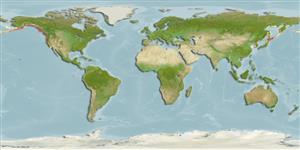>
Perciformes/Zoarcoidei (Eelpouts and pricklebacks) >
Scytalinidae (Graveldivers)
Etymology: Scytalina: Greek, skytale, -es = branch; cylindrical piece of wood used by Spartan army, with a paper tied around it containing orders or comunnications from the courts. It is also a kind of fish (Ref. 45335).
More on authors: Jordan & Gilbert.
Environment: milieu / climate zone / depth range / distribution range
Ecologie
marien demersaal. Temperate
Eastern Pacific: Bering Sea coast of Alaska to Diablo Cove, central California, USA.
Grootte / Gewicht / Leeftijd
Maturity: Lm ? range ? - ? cm
Max length : 15.0 cm TL mannelijk / geslacht onbekend; (Ref. 2850)
Dorsale stekels (totaal): 0; Dorsale zachte stralen (totaal): 41-51; Anale stekels 0; Anale zachte stralen: 36 - 41. Caudal rounded. Pectorals small.
Found in rocky areas, tide pools and off beaches (Ref. 2850). Burrows in loose gravel and sand or among broken shells on the bottom (Ref. 2850). May not utilize the intertidal zone for reproductive and recruitment purposes (Ref. 56899).
Levenscyclus en paargedrag
Maturiteit | Voortplanting | Paaien | Eieren | Fecunditeit | Larven
Eschmeyer, W.N., E.S. Herald and H. Hammann, 1983. A field guide to Pacific coast fishes of North America. Boston (MA, USA): Houghton Mifflin Company. xii+336 p. (Ref. 2850)
Status op de Rode Lijst van het IUCN (Ref. 130435)
Gevaar voor de mens
Harmless
Gebruik door de mens
Meer informatie
Lokale namenSynoniemenMetabolismePredatorenEcotoxicologieVoortplantingMaturiteitPaaienPaaiaggregatiesFecunditeitEierenOntwikkeling van de eieren
Leeftijd/GrootteGroeiLengte-gewichtLengte-lengteLengtefrequentiesMorfometrieMorfologieLarvenLarvale populatiedynamiekRekruteringAbundantieBRUVS
ReferentiesAquacultuurAquacultuurprofielKweeklijnenGeneticaElectrophoresesErfelijkheidZiektesVerwerkingNutrientsMassaconversie
Tools
Speciale rapporten
Download XML
Internetbronnen
Estimates based on models
Preferred temperature (Ref.
123201): 5.7 - 14.8, mean 9.8 °C (based on 220 cells).
Fylogenetische diversiteitsindex (Ref.
82804): PD
50 = 1.5000 [Uniqueness, from 0.5 = low to 2.0 = high].
Bayesian length-weight: a=0.00389 (0.00180 - 0.00842), b=3.12 (2.94 - 3.30), in cm total length, based on all LWR estimates for this body shape (Ref.
93245).
Trofisch niveau (Ref.
69278): 3.3 ±0.5 se; based on diet studies.
Fishing Vulnerability (Ref.
59153): Low vulnerability (10 of 100).
